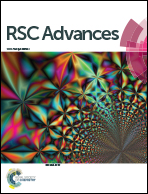Solution-phase synthesis of γ-In2Se3 nanoparticles for highly efficient photocatalytic hydrogen generation under simulated sunlight irradiation†
Abstract
Hexagonal indium selenide (γ-In2Se3) nanoparticles were successfully synthesized by a hot-injection method using triethylene glycol as a solvent. The structure and morphology of the obtained nanoparticles were characterized by powder X-ray diffraction (XRD), X-ray photoelectron spectroscopy (XPS), scanning electron microscopy (SEM), and transmission electron microscopy (TEM). Phase-pure γ-In2Se3 nanoparticles could be obtained at a relatively low temperature of 220 °C. Further increasing the reaction temperature leads to enhanced crystallinity of the γ-In2Se3 nanoparticles, which favors improving the photocatalytic activity. The γ-In2Se3 nanoparticles synthesized at 250 °C exhibit excellent and stable photocatalytic hydrogen generation under simulated sunlight irradiation, which might be attributed to the strong absorbance both in the UV and visible light regions as well as their nano-sized morphology.


 Please wait while we load your content...
Please wait while we load your content...